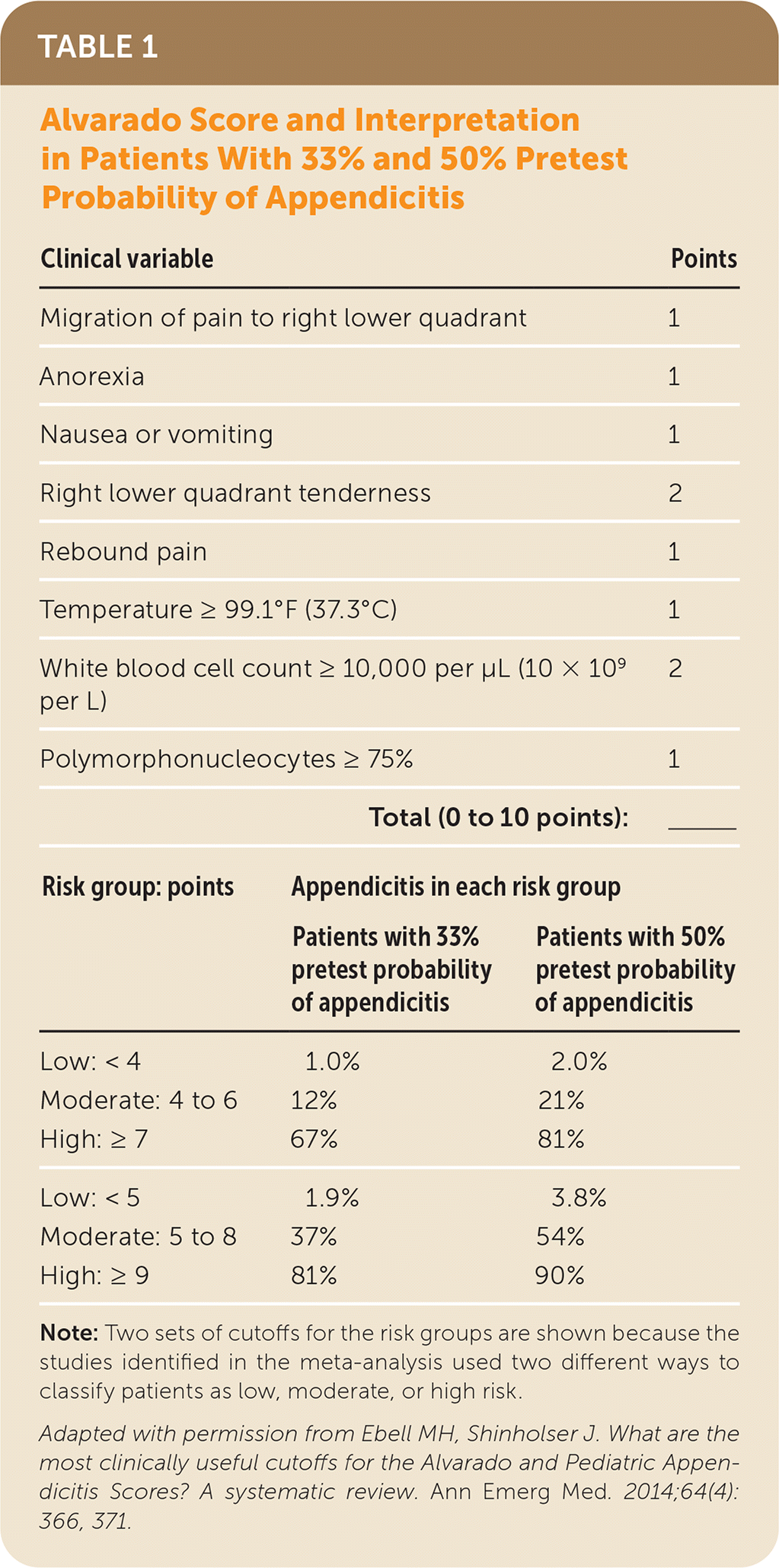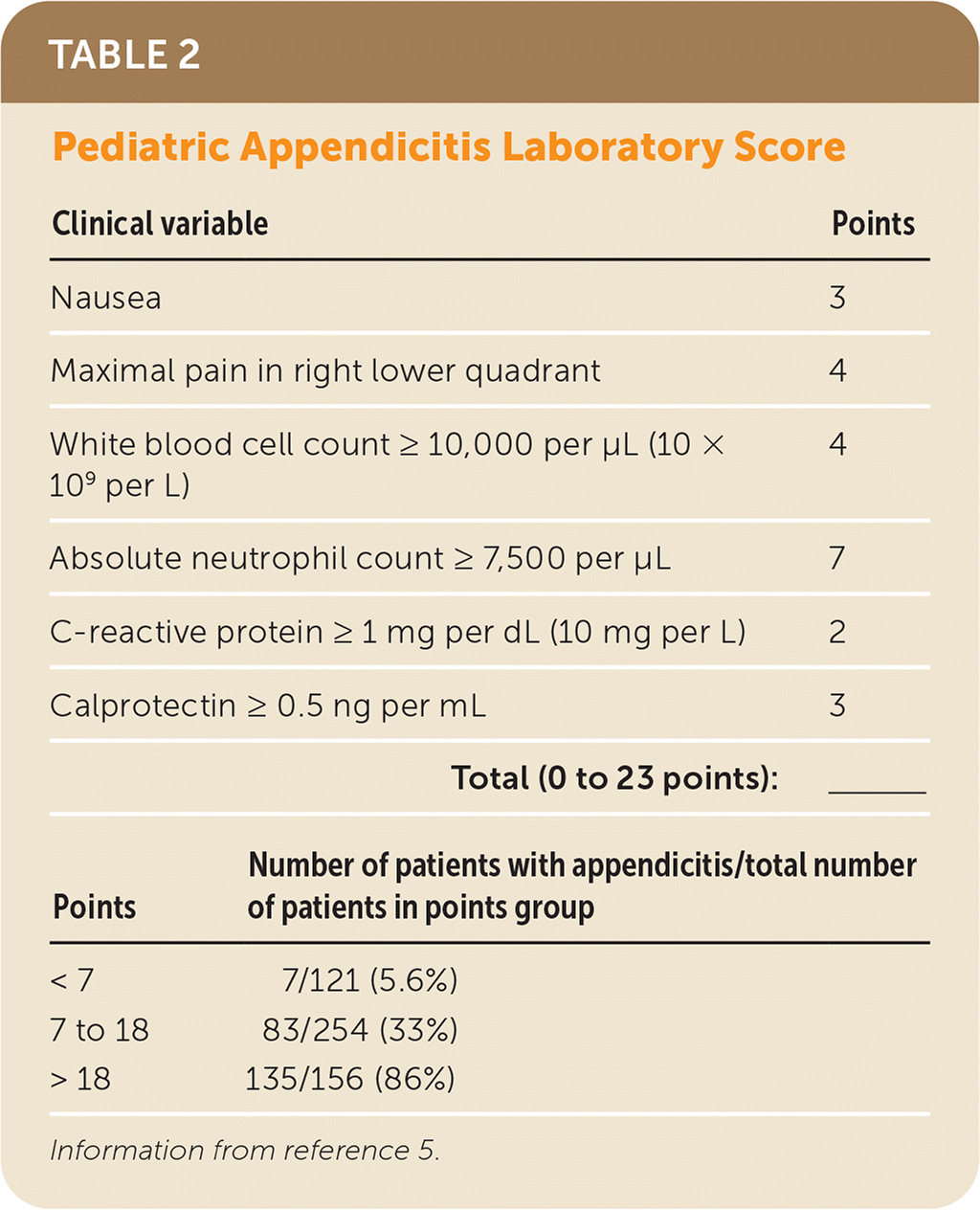
Am Fam Physician. 2023;107(3):301-302
Author disclosure: No relevant financial relationships.
Clinical Question
In children and adolescents with lower abdominal pain, is there a way to identify low-, moderate-, and high-risk groups for suspected appendicitis?
Evidence Summary
The incidence of appendicitis in North America is approximately one episode per 1,000 people per year.1 The peak incidence in children and adolescents 10 to 19 years of age is 2.3 episodes per 1,000 people per year, with a lifetime prevalence of 8.6% for males and 6.7% for females.2 The evaluation of children and adolescents with clinically suspected appendicitis has potential harms, including unnecessary exposure to ionizing radiation from abdominal computed tomography scans at an age when tissue is more radiosensitive and unnecessary surgery in patients without appendicitis, which is more common in females.3
To help physicians distinguish children and adolescents with appendicitis from those with nonsurgical conditions, clinical prediction rules have been developed and prospectively validated. Ideally, these appendicitis risk scores would identify low-risk patients who could be sent home with close follow-up, moderate-risk patients who may require observation or imaging, and high-risk patients who would generally be managed surgically.
The two best known risk scores are the Alvarado Score and the Pediatric Appendicitis Score. A systematic review of these risk scores found that the overall likelihood of appendicitis in children and adolescents with acute abdominal pain or clinically suspected appendicitis was 33%.4 The risk scores are similar, assigning 1 point each for migration of pain to the right lower quadrant, anorexia, nausea or vomiting, fever, and 75% or more polymorphonucleocytes (left shift). The Pediatric Appendicitis Score gives 2 points for cough, percussion, or hopping that causes right lower quadrant pain, whereas the Alvarado Score gives 1 point for rebound pain. Leukocytosis, defined as 10,000 white blood cells per μL (10 × 109 per L) or more, is given 2 points by the Alvarado Score and 1 point by the Pediatric Appendicitis Score.4
The meta-analysis identified 11 studies that evaluated one or both scores in children and adolescents. For the Alvarado Score, a total of less than 4 points identified a low-risk group with a 1% likelihood of appendicitis given a 33% pretest probability and a 2% likelihood given a 50% pre-test probability. Children and adolescents with a score of 9 points or more had an 81% likelihood of appendicitis given a 33% pretest probability and a 90% likelihood given a 50% pretest probability. A score of less than 4 points on the Pediatric Appendicitis Score did not identify a low enough risk group to be useful, although it performed similarly to the Alvarado Score at identifying high-risk patients with a score of 8 points or more.4 The Alvarado Score and interpretation are summarized in Table 1.4

| Clinical variable | Points | |
|---|---|---|
| Migration of pain to right lower quadrant | 1 | |
| Anorexia | 1 | |
| Nausea or vomiting | 1 | |
| Right lower quadrant tenderness | 2 | |
| Rebound pain | 1 | |
| Temperature ≥ 99.1°F (37.3°C) | 1 | |
| White blood cell count ≥ 10,000 per μL (10 × 109 per L) | 2 | |
| Polymorphonucleocytes ≥ 75% | 1 | |
| Total (0 to 10 points): | ______ | |
| Risk group: points | Appendicitis in each risk group | |
| Patients with 33% pretest probability of appendicitis | Patients with 50% pretest probability of appendicitis | |
| Low: < 4 | 1.0% | 2.0% |
| Moderate: 4 to 6 | 12% | 21% |
| High: ≥ 7 | 67% | 81% |
| Low: < 5 | 1.9% | 3.8% |
| Moderate: 5 to 8 | 37% | 54% |
| High: ≥ 9 | 81% | 90% |
New biomarkers have been identified and a new clinical prediction rule, the Pediatric Appendicitis Laboratory Score, has been developed and prospectively validated at the same institution.5 It incorporates signs and symptoms as well as evaluating C-reactive protein, calprotectin, white blood cell count, and absolute neutrophil count levels. In the validation sample, 49% had appendicitis and the authors used a score of less than 7 to define a low-risk group that was 99.2% sensitive with a negative likelihood ratio of 0.03. The Pediatric Appendicitis Laboratory Score is shown in Table 2.5 Although the Alvarado Score is more practical in the outpatient or primary care setting, the Pediatric Appendicitis Laboratory Score provides additional guidance when these biomarkers are available.

| Clinical variable | Points |
|---|---|
| Nausea | 3 |
| Maximal pain in right lower quadrant | 4 |
| White blood cell count ≥ 10,000 per μL (10 × 109 per L) | 4 |
| Absolute neutrophil count ≥ 7,500 per μL | 7 |
| C-reactive protein ≥ 1 mg per dL (10 mg per L) | 2 |
| Calprotectin ≥ 0.5 ng per mL | 3 |
| Total (0 to 23 points): | _______ |
| Points | Number of patients with appendicitis/total number of patients in points group |
| < 7 | 7/121 (5.6%) |
| 7 to 18 | 83/254 (33%) |
| > 18 | 135/156 (86%) |
Applying the Evidence
A 12-year-old child presents with right lower quadrant abdominal tenderness. The pain began in the right lower quadrant, and he has nausea and anorexia but no rebound pain or fever. His white blood cell count is 12,000 per μL (12 × 109 per L), and he has 80% polymorphonucleocytes. You calculate an Alvarado Score of 7 and refer him to the emergency department for further evaluation. A C-reactive protein level of 3 mg per dL (30 mg per L) and calprotectin level of 1.2 ng per mL were obtained for a Pediatric Appendicitis Laboratory Score of 23. He is referred for surgery.

